A New Battle Over Mary Nohl Home
Proposal to create cultural overlay district bitterly opposed by some Fox Point residents.
Every decade or so, with the regularity of a hothouse corpse flower bursting into bloom, officials of the Village of Fox Point consider a zoning modification to allow limited access to the Mary Nohl home where the artist [1914-2001] lived and where she created an environment of her own inspiration and labor from found objects, many washed up on the beach outside her door. The home, where she spent the majority of her long life, is listed on the State and National Registers of Historic Places. The dwelling itself is covered with her bas-relief sculptures. Although most of the interior has been relocated, the home, with outdoor concrete sculptures made on-site by the owner, remains. And remains a point of contention.
It is as if the timing of a malodorous titan arum efflorescence coincided with a shoreline alewife die-off. The objectors have won every encounter since the 20th century. The battle is once again engaged. A Joint Meeting of the Plan Commission and Board of Trustees is scheduled for 7:00 p.m. on Tuesday, Jan. 31, at the Municipal Building, 7200 N. Santa Monica Blvd., for the purpose of considering a Cultural Overlay District for the Nohl Art Environment requested by Creation & Preservation Partners [CAPP], Inc., an affiliate of the John Michael Kohler Arts Center, [JMKAC].
Village Manager Scott A. Botcher offers this cautionary notice in a Jan. 5 memo:
Anyone who wishes to attend in person may certainly do so; at the same time, given the probability of an overflow crowd, we will be reminding interested parties that they will be able to participate virtually.
Those inclined may do so via this link:
https://us02web.zoom.us/j/83896123111
A Geopolitical Divide of the First Class
The Village of Fox Point Code of Ordinances Section 745-22 permits the establishment of a Cultural Overlay District atop existing zoning for the purposes of operating an Art Gallery, Museum or a Library, subject to certain provisions, including submittal of a site plan, detailed hours of operation, restrictions on number of visitors, height limits, and other conditions, including demonstrating the financial viability of the venture.
To meet the requirements of the ordinance, any proposal must be:
in conformity with the general character of the Village and would not be contrary to the general welfare and economic prosperity of the Village or the immediate neighborhood.
Significantly, the contemplated use will not:
- Cause material depreciation in property values in the immediate neighborhood.
- Materially adversely affect the use and enjoyment of property in the immediate neighborhood.
- Create traffic beyond the capacity of the street system to reasonably serve it.
These three items are hot points of contention and may lead to fireworks at the public hearing. There, Nohl supporters from all over must face opposition from residents of a narrow strip of about 60 lake-level properties. The sinuous Beach Drive is the single street connecting them to the mainland and the great metropolis 125 feet above, where the winding, bluff-hugging road dead-ends at N. Lake Drive and where the real world begins.
The geopolitical divide between the residents of Beach Drive’s 200 or so acres (depending on how much of the uninhabitable bluff you count) and the remainder of Fox Point’s 1,700 acres, where the great majority of its 6,000 residents are housed in over 3,000 residential units, is striking. On Beach Drive, powder blue signs reading “No Nohl Museum,” are seen in abundance, yet are visible nowhere else in the village, strikingly demonstrating the NIMBY nature of the opposition.
The Proposal
According to the submittal:
CAPP and JMKAC’s primary purposes are:
- to preserve and protect the Mary Nohl House and the collection;
- for the exhibition, examination and study by smaller groups of invited scholars, collectors, historians, educators, and others; and
- to encourage interested parties and larger groups to visit the Art Preserve opened by JMKAC in 2021 at 3636 Lower Falls Road in
Sheboygan, Wisconsin, which houses the vast majority of Mary Nohl’s work.
The groups also would like to:
- construct an ancillary building of not greater than 4,000 square feet to house artists in residence and a caretaker;
- allow visits of one to four scholars at pre-arranged times
- permit two special events per year accommodating no more than 80 guests
- allow no visiting groups larger than ten individuals, nor more than twenty people per day, with access only by shuttle, yet not more than three times per week, and with no traffic during peak rush hours
- offer the chance for school children of Fox Point to visit in small groups
- invite neighbors over for private visits.
Yet there remain considerable objections.
Of no question is the financial viability of the Kohler-related entities, which have spent over $4 million on the site since its 1996 acquisition, five years before the death of Nohl. With an agreement in place, it anticipates spending millions more. The JMKAC, founded by the late Ruth Kohler (1941-2020) is internationally recognized for its collection of artists’ environments both in situ at 15 US locations and in its Art Preserve in Sheboygan. You could say she invented the genre. Although she could afford any jewel in the world, Ruth was occasionally photographed wearing a simple fish pin wrought by Nohl. In 2022 her bequest of $440 million established The Ruth Foundation For The Arts, based in Milwaukee. It is the nation’s largest such organization.
Fears of ‘Unknown Persons,’ Declining Property Values, Loss of Tax Revenue
Beach Drive objectors to the project include Richard B. Price, concerned that he will lose his right to “quiet enjoyment” of his surroundings, which would be afflicted by “increased traffic, on-street parking, non-resident/unknown persons walking our streets, the inevitable decline in property values of adjacent properties and the loss of tax revenue for Fox Point.”
Mike Stoessl, also of Beach Drive, calls the proposal “…an attempt to shift some cost from Kohler Arts Center to the property taxpayers in Fox Point, and to force Beach Dr. to become a fundraising venue for Kohler.”
In fact, as has been the case for years, the village government will receive its share of property taxes, or about $13,000 per year, based on the current assessed valuation of $2,198,500.
Mark E. Hodgson M.D. writes from “pretty far north on Beach, such that my impact is less in this situation,” yet still has plenty to say:
a public facility in the middle of a residential area is inappropriate at so many levels … It is basically a bad headstone to one’s-self and dead property forever. … This happens when someone has money and no heirs with suitable levels of vanity and narcissism to set up such a massive tombstone to themselves…
Neither Ruth Kohler nor Mary Nohl married or had children. Ms. Nohl left a $11 million endowment to fund the annual juried artist competition bearing her name. The century-old home predates 80 per cent of the other dwellings on Beach Drive, where many newer buildings have been demolished for new construction.
Bonnie Bockl Joseph, who with her husband Leon Joseph has hosted many political fundraisers at their home, with an attendance that would exceed that permitted for the two annual Nohl special events, and whose family owns the artist-filled Marshall Building in Milwaukee’s Historic Third Ward, writes to declare their objection, beginning with a candid admission that the Beach Drive mansion they occupy is:
…the furthest house from Mary Nohl’s house.
Yet they have two minor grandchildren living quite near the Nohl Home and their
home will be adversely affected by any attempt to gather many many cars to this spot. … They are attempting to cross over the drive that leads to our daughters house … it will be off the tax rolls … it will have buses often in a parking lot on the lake??? it will have debris and will encourage site-seers to travel the one lane roads that will be a danger to us all on beach drive.
In fact, the drive that leads to her daughter’s house is marked as “Village Street” in The National Survey Service Map 16319-M, dated November, 1940. (The document was included in the application filed by Kohler.) It should further be noted that Beach Drive is a public thoroughfare, open to “site-seers,” unknown persons walking the street, and even bicyclists with the stamina to make it back up the hill. Suburban citizen objections to changes in their environment never fail to mention crime as a concern: Kohler would share its security footage with the Fox Point Police Department.
However, crime was much more of a problem when Nohl lived alone in the house, behind a chain link fence she later augmented with a topping of concertina wire. Intruders would steal or vandalize the sculptures at “The Witch’s House” — and in 1973 even burnt one in place, within feet of the wooden home. As Nohl and the firefighters watched the embers, Mary decided the iron support posts of the demised wooden sculpture would make a good armature for a replacement made of concrete. Harder to steal and impossible to incinerate, she reckoned. The property is now filled with such artifacts, giving every indication they want to stay where they were made.
A Voice of Support
One Beach Drive resident submitted a letter in support of the project. Deborah Kern wrote, “as a longtime resident of Beach Drive and a longtime admirer of Mary Nohl’s art, it is important that the proposal is accepted. I have received an anonymous letter from the No Nohl Museum group and am dismayed at their alarmist and exaggerated disapproval. I sincerely hope that the village does not get swayed by a few over the good of all.”
Kern goes on to say:
Mary Nohl was an important Wisconsin woman artist who has not only created a body of work specific to this location but has also created the Mary Nohl Fellowship at the Greater Milwaukee Foundation to further other artistic careers.
She points out that the museum will not be open to the public, that the village has not suffered from the Chipstone overlay district, traffic will be manageable, and that it will be competently operated by “the world’s leading center for research and presentation of this important and unique art form.”
Kern says all of her time is occupied with the Bronzeville Center for the Arts, where construction is underway on a 3,500 square foot gallery at 507 E. North Ave., and a redevelopment of the adjacent 3.4 acre site at 2313 N. King Dr. Yet even so, she had a few spare minutes to order “Save the Nohl House” signs to counter the sea of “No Nohl Museum” signs seen on Beach Drive. Kern expects her signs, to be delivered Monday, will get wider distribution, with perhaps even a few on Beach Drive itself.
Is the Fox Point Beach Club Agreement a Key?
Overlooked by both supporters and detractors of the Nohl, and unknown to practically everybody, is the Fox Point Beach Club, in operation at 7704 N. Beach Dr. since 1909. It is a nonstock corporation limited to 60 “member units.” There is a long waiting list, presumably populated by offspring of current unit holders. Such has been the case for generations.
According to Atty. Douglas H. Frazer, who documents Fox Point history, the Beach Club is:
The village’s oldest continually operating institution. Unpretentious and understated, it is a rustic cottage for its members to enjoy the beauty and quiet of the lake.
The description of the property could also serve for the Nohl home. And so might a 1984 agreement between the village and the club.
According to the agreement:
The Beach Club co-exists in harmony in the context of the residential neighborhood in which it sits. It is a longstanding tribute to continuity, and the quiet, family-oriented nature of our village.
Again, the same could be said about the Nohl house. Yet there are no yard signs opposing the club, nor are there records of complaints about its operation, not even its “Nashville Party” held on June 18th, 2022, which sounds about as rollicking as Fox Point could possibly get. Facebook photographs show future Mary Nohls stacking beach pebbles and forming them into sculptures, learning as they play. I asked Deborah Kern her opinion of this Beach Drive amenity. She said, “I live next door to the FP Beach Club and I have no problem with visitors or noise.”
She is confident the same will be the case for the Nohl House and its neighbors if the Board of Trustees approves the proposal.
Photo Gallery
Further Reading and Links
- Plenty of Horne: Mary Nohl vs. NIMBY – October 2013
- Back in the News: Mary Nohl Home – March 2014
- Why the Mary Nohl Home Must Be Moved – July 2014
- NRHP Sheet on Nohl House
- Agenda documents
Plenty of Horne
-
Milwaukee Modernism Gains National Awards
 Dec 15th, 2025 by Michael Horne
Dec 15th, 2025 by Michael Horne
-
New Rainbow Crosswalks Mark Milwaukee’s LGBTQ+ History
 Oct 8th, 2025 by Michael Horne
Oct 8th, 2025 by Michael Horne
-
Welcome Back, Tripoli Country Club!
 May 27th, 2025 by Michael Horne
May 27th, 2025 by Michael Horne


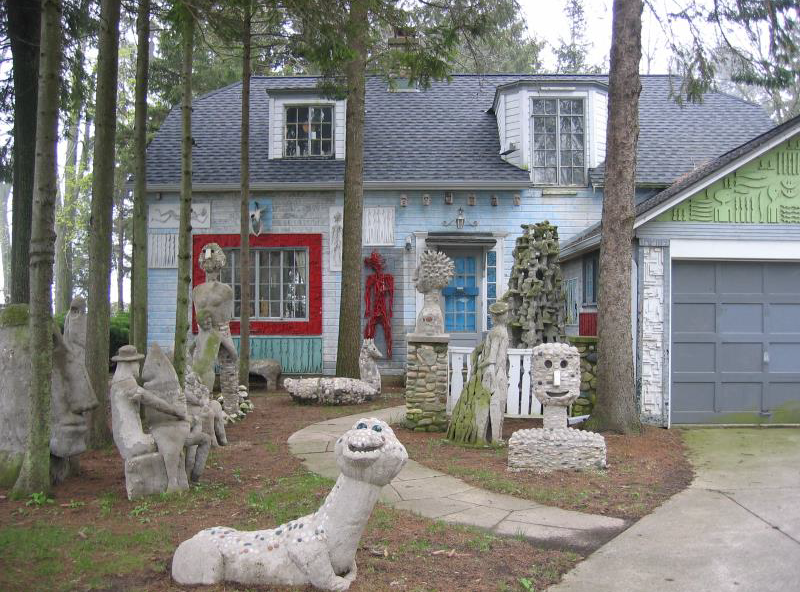
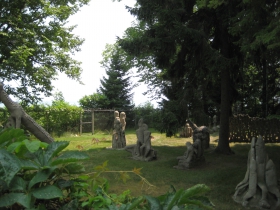
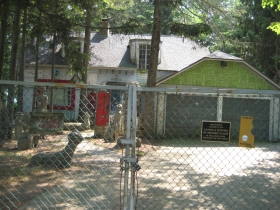
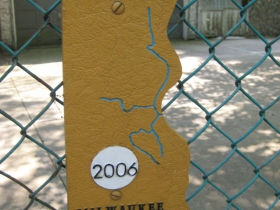
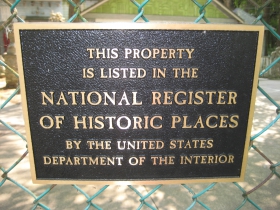
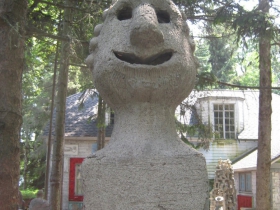
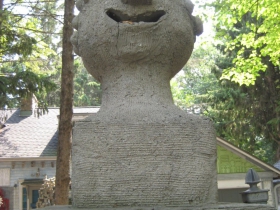




















These extremely wealthy people have no problem with holding huge political fundraising parties. Dozens if not hundreds of people descend on sponsors’ compounds, many if not all are on Beach Drive or close to it.
My analysis of this problem is that Fox Point believes that a handful of people visiting a unique artist’s home is bad, while far more people approaching a hundred-plus at a time is good.
We wonder where “Karens” come from. Now, we know…
Exclusive = exclusionary
Full disclosure, I have no skin in this game living 15 miles away.
As a Menomonee Falls teenager growing up in in the late 1970s, we knew it as the Witch’s House (as does Google today). A night-time drive-by of it – along with the Hogsback in Ritchfield – was a right of passage, led by someone who’d been there before as they are off the beaten path. The chief attraction was the depressing grey weirdness of the sculptures which gave credence to the tale of a widow driven mad by the death of her husband and son, mariners lost to a Great Lakes storm.
It is my understanding that much of her work has already been moved to the Kohler Museum in Sheboygan. Move the rest out of this tiny isolated cul-de-sac which does not lend itself to any sort of public venue. Unless there is a permanent police presence at the main road, limited usage is at best naive, at worst a cynical lie to push an agenda.